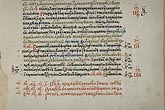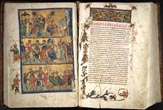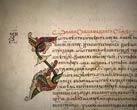500 Years of the Skaryna Bible:
coloured books from the «Faust Study»
The Psalter published by Francysk Skaryna in 1517 in Prague is considered to be the first printed Belarusian book. Actually, the language of Skaryna's books is a variety of East Slavonic spoken in the Grand Duchy of Lithuania. Then Skaryna published 23 books of the Old Testament under the common name Biblia Ruska (the Russian Bible) but in separate editions (each with its title page and page numbering). In 1517, Skaryna issued 4 books, in 1518 he published twice more, in 1519 - already 11 ones. They today are the greatest bibliographic rarity. No "publisher's" binding of Skaryna's books has survived. The copies of the Prague Bible held in our Faust's Study are bound in covers with the monogram "IPB" (the Imperial Public Library is the former name of our library). They are compiled by librarians during the 19th century.
- Francysk Skaryna
- Prague Printing House
- Coloured Illustrations
Francysk Skaryna
Skaryna's Bible was not the first to appear in Byelorussia.
Ten years before Skaryna's publication in Prague, the first manuscript books of the Old and New Testaments were produced in the Grand Duchy of Lithuania by Matvei Ioannovich. Matvei Ioannovich was a scribe from the Russian Chancellery of the Grand Duchy of Lithuania, he was nicknamed Matthew the Tenth because he was the tenth child of his family.
Matthew the Tenth began to copy the biblical books in the capital city of Vilna (now Vilnius)in 1502. Perhaps, the manuscript was intended as a gift for the Queen of Poland and the Grand Duchess of Lithuania Elena, the wife of King Alexander I Jagiellon. To produce the presentation copy, the scribe was relieved of his duties of public service. The gift was executed according to the rank of the intended recipient: Matthew wrote on full size sheets of high-quality German paper in a fine calligraphic handwriting, decorating the initials and headpieces with a multicoloured ornament of the Byzantine style. In the middle of the manuscript (before the text of the Psalter), he placed a three-part miniature depicting biblical scenes.
Matthew the Tenth wrote some texts of the New Testament in ink of different colours: he applied gold for Christ's words and teachings and for quotations from the Old Testament, blue ink is used for remarks introducing direct speech. the second scribe participated in the work on the manuscript (anonymous, identified by handwriting), marked the initial stanza of each song of the Paschal canons with blue and green ink.1 Thus, the first in the Grand Duchy of Lithuania handwritten collection of biblical books was multicoulored and was magnificently decorated.
Did Skaryna know about the Bible of Matthew the Tenth?
After the death in 1506 of King Alexander I Jagiellon, the unfinished royal gift ceased to be needed. However, Matthew the Tenth continued to copy the Bible. From the capital, he moved to the Suprasl monastery (50 kilometers from Grodno), where he finished his work. And on the last sheet of the manuscript, he placed his detailed autobiography. This lengthy postscript probably appeared as soon as he was made aware that the book would not become a gift "for the top circles".
After Matthew the Tenth finished his work, traveling monks and pilgrims spread a rumor about a wonderful manuscript of the Bible books around the cities, estates of the nobles, the monasteries and offices where the majority of the literate population of the Grand Duchy of Lithuania lived and worked.
The Manuscripts Department of the National Library of Russia possesses two parchment Gospels produced by Matthew the Tenth. They originate from the Polotsk Monastery of John the Baptist. The donation records are dated to the early 16th century, they are very similar in both books: the description of the donation is identical, but there are differences in the list of witnesses, in particular when mentioning the head of the monastery Evfimiy Toropka.
Toropka means from Toropets, the most eastern city of the of the Grand Duchy of Lithuania. Matthew the Tenth also comes from Toropets. In his autobiographical entry, he states with pride: his sister was the hegumenness of the Monastery of John the Baptist in Toropets, his brother Evfimiy became hegumen of the Monastery of John the Baptist in Polotsk, the brother Nikifor was the monk of the Novgorod Khutyn Monastery2.
At the early 16th century, Polotsk was a capital of a voivodship, with 10 thousand inhabitants. Most of them were acquainted with each other, and wealthy residents (the merchant Skaryna was among them) were well known by the whole city. Everyone knew the heads of the monasteries (one Catholic and four Orthodox) - in fact, the all citizens learnt how to read and wright in monastic schools.
The Polotsk inhabitants could not but know about the wonderful book on which the brother of the head of the monastery of John the Baptist had worked over five years; Francysk Skaryna also knew about it. He knew that this book was inaccessible to nobody in Polotsk.







